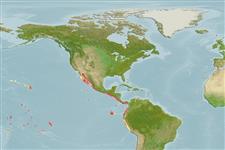Environment: milieu / climate zone / depth range / distribution range
Ekologi
marina bottenlevande; djupintervall 0 - 300 m (Ref. 9269), usually 0 - 95 m (Ref. 9269). Subtropical; 34°N - 15°S
Eastern Pacific: Santa Catalina Island, southern California, USA to Peru.
Size / Vikt / Age
Maturity: Lm ? range ? - ? cm
Max length : 33.0 cm TL hane/ej könsbestämd; (Ref. 55763); common length : 15.0 cm TL hane/ej könsbestämd; (Ref. 55763)
Taggstrålar i ryggfenan (totalt): 3; Mjukstrålar i ryggfenan (totalt): 12-14; Taggstrålar i analfenan 0; Mjukstrålar i analfenan: 8 - 9; Ryggkotor: 19. Branchiostegal rays: 6 (Ref. 36491).
Adults inhabit rocky areas, including the intertidal zone. Found on sandy and muddy bottoms (Ref. 9269). Young individuals feed heavily on crustaceans but as they grow bigger, they consume more and more fish, sometimes catching and eating fishes their own size (Ref. 4930).
Life cycle and mating behavior
Könsmognad | Reproduktion | Lek | Ägg | Fecundity | Larver
Eschmeyer, W.N., E.S. Herald and H. Hammann, 1983. A field guide to Pacific coast fishes of North America. Boston (MA, USA): Houghton Mifflin Company. xii+336 p. (Ref. 2850)
IUCN Red List Status (Ref. 130435)
Threat to humans
Harmless
Human uses
Ytterligare information
referenserVattenbrukVattenbruksprofilAvelslinjerGenetikElectrophoresesÄrftlighetSjukdomarBehandlingNutrientsMass conversion
MedarbetareBilderStamps, Coins Misc.LjudCiguateraHastighetSimsättGälytaOtolithsHjärnstorlekSyn
Verktyg
Special reports
Download XML
Internet-källor
Estimates based on models
Preferred temperature (Ref.
123201): 15.7 - 28.8, mean 23.3 °C (based on 270 cells).
Phylogenetic diversity index (Ref.
82804): PD
50 = 0.5312 [Uniqueness, from 0.5 = low to 2.0 = high].
Bayesian length-weight: a=0.01995 (0.00906 - 0.04395), b=3.01 (2.83 - 3.19), in cm total length, based on all LWR estimates for this body shape (Ref.
93245).
Trofisk nivå (Ref.
69278): 4.0 ±0.66 se; based on food items.
Resiliens (Ref.
120179): Hög, lägsta populationsfördubblingstid mindre än 15 månader (Fec assumed to be > 10,000).
Fishing Vulnerability (Ref.
59153): Low vulnerability (23 of 100).
